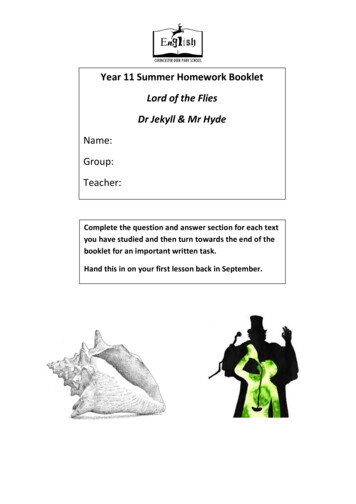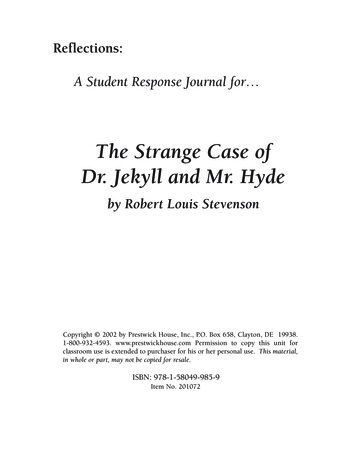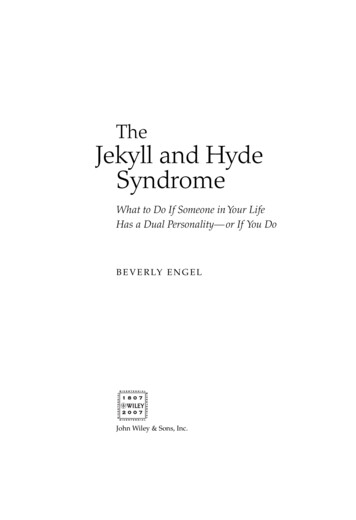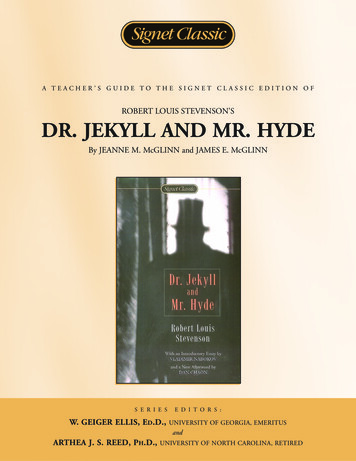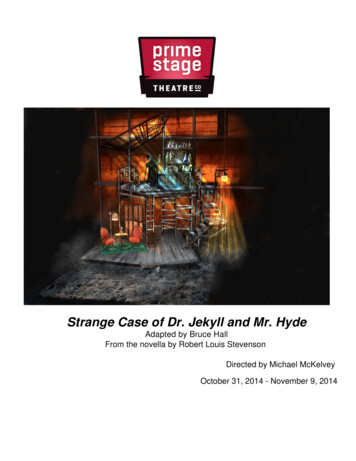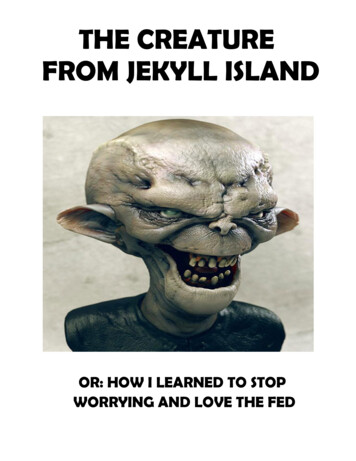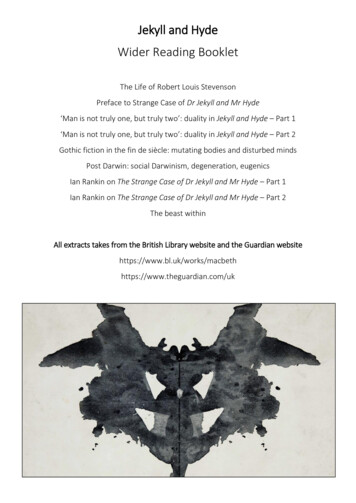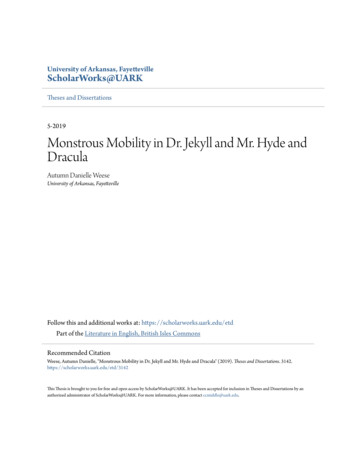
Transcription
University of Arkansas, FayettevilleScholarWorks@UARKTheses and Dissertations5-2019Monstrous Mobility in Dr. Jekyll and Mr. Hyde andDraculaAutumn Danielle WeeseUniversity of Arkansas, FayettevilleFollow this and additional works at: https://scholarworks.uark.edu/etdPart of the Literature in English, British Isles CommonsRecommended CitationWeese, Autumn Danielle, "Monstrous Mobility in Dr. Jekyll and Mr. Hyde and Dracula" (2019). Theses and Dissertations. 3142.https://scholarworks.uark.edu/etd/3142This Thesis is brought to you for free and open access by ScholarWorks@UARK. It has been accepted for inclusion in Theses and Dissertations by anauthorized administrator of ScholarWorks@UARK. For more information, please contact ccmiddle@uark.edu.
Monstrous Mobility in Dr. Jekyll and Mr. Hyde and DraculaA thesis submitted in partial fulfillmentof the requirements for the degree ofMaster of Arts in EnglishbyAutumn WeeseJohn Brown UniversityBachelor of Arts in English, 2012May 2019University of ArkansasThis thesis is approved for recommendation to the Graduate Council.Lissette Lopez Szwydky-Davis, Ph.D.Thesis DirectorWilliam Quinn, Ph.D.Committee MemberSean Dempsey, Ph.D.Committee Member
AbstractThis thesis explores Late Victorian Gothic texts that are central to theories on monstrosityin terms of mobility by examining Dr. Jekyll and Mr. Hyde and Dracula. The goal of this projectis to survey the ways in which two exemplary monsters, Mr. Hyde and Count Dracula, promotemobility for others and themselves as an inherent part of their monstrosity. The variety of thismobility is demonstrated by examples showing how monsters move and encourage movement inways that are social and transformative as well as physical. Because social mobility is essentialto these movements, this study also considers the societies these monsters enter and interrupt.The gentleman bachelors of Dr. Jekyll and Mr. Hyde and Dracula's Crew of Light and thewomen they seek to protect are presented as monolithic groups that the monster joins,transforms, and spurs into movement. By identifying mobility as one of the main attributes ofmonstrosity, this argument seeks to not only add to the copious amount of scholarship alreadydone on these works but also to reconcile some of them since many of the most criticallycontroversial aspects of these texts are rooted in the monster's mobility. A study focused onmovement not only adds something that is missing from the existing discussion on these seminalmonsters but also provides a new framework through which to discuss constantly evolvingtheories of monstrosity.
2019 by Autumn WeeseAll Right Reserved
Table of ContentsIntroduction1Dr. Jekyll's Good Name and His Illegitimate Heir:Social Mobility in Dr Jekyll and Mr. Hyde12The Monstrous Mr. Hyde and the Newly-Mobile Gentlemen Bachelors:Transformative Mobility in Dr. Jekyll and Mr. Hyde24The Professional District, the Slums of Soho, and “Mixed Spaces:”Physical Mobility in Dr. Jekyll and Mr. Hyde34The Monstrous New Woman and Masculinity at Stake:Social Mobility in Dracula44Monstrous Heroes and Up-to-Date Medievalism:Transformative Mobility in Dracula61“Reverse Colonization” and Dracula's Travel War:Physical Mobility in Dracula71Conclusion84Works Cited88
1IntroductionIn the shadow of the Carpathians, an elderly woman wrings her hands and pleads to anEnglishman, a solicitor, to stay at her inn a while longer. She knows, or at least suspects, themonster that waits at the end of his journey. Worried for his safety, she asks, “Do you knowwhere you are going, and what you are going to?” (Stoker 9). The Englishman, very simply, doesnot know, but this does not stop him. He has received an important, if eccentric, invitation toconduct business with a certain Count in the area and cannot ignore it. His business is“imperative,” and he insists, “I must go” (Stoker 9). Back in London, a respectable lawyer fromthe West End is also impelled towards movement when the police question him about the violentdeath of one of his clients. An upstanding gentleman has been clubbed to death in the street, andsurely only a monster could do such a thing. The lawyer has his own suspicions and seems tosteel himself before agreeing to begin his journey. “If you will come with me in my cab,” heexplains, “I think I can take you to his house” (Stevenson 27). The lawyer, an officer at his side,approaches the suspect streets of Soho through a thick fog because, like the solicitor traveling ina foreign land, he too “must go.” Both are impelled to go and meet their monsters as the monster,whether or not he is yet recognized as such, makes a call that cannot be ignored.One of the “Seven Theses” on monstrosity that Jeffrey Jerome Cohen offers in hisintroduction to Monster Theory is that “the monster polices the borders of the possible” (12). Heargues that “the monster stands as a warning against exploration” and shows “that one is betteroff safely contained within one’s own domestic sphere than abroad” (J. Cohen 12). Cohendeduces from this that “the monster prevents mobility (intellectual, geographic, or sexual)” sinceto move under these circumstances “is to risk attack by some monstrous border patrol” (12). Thisreasoning holds that monsters, despite moving through border spaces themselves, cause their
2human counterparts to freeze in fear. The following project, however, argues the opposite:monsters actually promote human mobility. While the fear of crossing borders may remain,monstrous threats tend to promote movement rather than stillness as humans either run awayfrom or towards the monster.The present argument examines Mr. Hyde and Count Dracula as exemplars of thismonstrous mobility. Robert Louis Stevenson’s Strange Case of Dr. Jekyll and Mr. Hyde (1886)and Bram Stoker’s Dracula (1897) have been selected, in part, because of their similarities sinceboth share a place in the canon of Late Victorian Gothic novels, are set primarily in England, andhave shared a similar afterlife in copious reiterations. Because these are foundational, seminalmonsters, it may later be concluded that their shared mobility is an attribute of monstrosity ingeneral, but it is at least clear that Hyde and Dracula are monsters who promote mobility forthemselves and others. This mobility is depicted as the ability to cross borders that are social(demarcating boundaries between parts of social constructs), transformative (demarcatingboundaries between changing identities), and physical (demarcating boundaries between actualspaces).Whether it is to run away from in fear or to chase as part of a hunt, monsters provide areason for physical mobility. Because they move and tend to move quickly, monsters are oftenrecognizable by their own mobility. In general terms, the physical fear of the monster is that itwill, indeed, move as it threatens to sneak up, chase, or attack. In addition to exceptional strengthand speed, Hyde and Dracula are both depicted with the supernatural ability to move in ways thathumans cannot like Dracula's riding into rooms on motes of dust and Hyde's movements that areoften described as demonic or animalistic. However, the monster’s physical mobility is notlimited to itself because, as the monster chases or attacks, it prompts its potential victims to run.
3As the following chapters will show, Hyde forces the gentlemen of London to cross the borderinto the slums of Soho to investigate him, and the humans of Dracula end by traveling all theway to Transylvania in order to execute their nemesis. In order to respond to the exceptionalmobility of the monster, others must move as well.Transformative mobility occurs as, in addition to encouraging movement, monsterschange people. Because they are Other, different in as many ways as possible, monsters tend toinhabit a network of colliding identities. In the identity of the monster, “one kind of differencebecomes another as the normative categories of gender, sexuality, national identity, and ethnicityslide together like the imbricated circles of a Venn diagram” (J. Cohen 11). The layering ofdifference evident in the monster explains, in part, the variety of interpretations they canproduce. Dracula's monstrosity, for example, has been attributed at times to his racial difference,sexual difference, and national difference among other things. This argument can be expanded,however, since the monsters not only exist in this space of “slippage” but also bring the humansthey hunt there with them (J. Cohen 10). Both Hyde and Dracula produce changes in theseemingly homogenous communities that they terrorize as they transform them, arguably, intosomething like the monster they fear and, certainly, into something different than they oncewere. By transforming the humans into something Other themselves, “monsters serve both tomark the fault-lines but also, subversively, to signal the fragility of such boundaries” (Graham12). The monster shows not only what the humans are not, but also what they are so close tobecoming.Monsters also promote social mobility because the strange positions that they placepeople in tend to allow space for movement in the existing social structure. Because of thelayering of difference mentioned earlier, the monster itself often inhabits the borders between
4existing structures of class, gender, and race. As the following argument will show, for example,Hyde is depicted as a rough member of the lower class at the same time that his position asJekyll's heir gives him potential as an up-and-coming gentleman. Similarly, even a cursory studyof Dracula can uncover the various readings of the vampire as both a supremely feminine andmasculine monster. In addition to crossing these social borders themselves, monsters bring theirvictims across these borders with them as the crises they create allow people to do more (or less)than norms would usually dictate. Hyde brings mobility to an otherwise rigid class structure asJekyll's association with the monster causes him to lose his social status and Utterson must travelto the slums of Soho to investigate. Dracula allows for a blurring of the strict borders limitinggender and sex in Victorian England as the men of Dracula become weak and impotent in theface of the vampire while the women are spurred onto action as a response to his threat. Themonster, then, is able to question boundaries and grant freedom from the norms that rule theprotagonists before his introduction.The complexities of gender and sex and class structure have been well documented inboth Dr. Jekyll and Mr. Hyde and Dracula, but the goal of the present argument is different inthat these subjects are being considered in terms of mobility instead of as ends unto themselves.The social anxieties latent in monster texts as popular as these have already been studied at greatlength, but the present argument seeks to explore the underlying cause of these already wellexamined themes. The movement that the monster makes possible is the source of these topicsthat have drawn so much critical attention, but the movement itself has often been ignored. Thislack of attention to movement is likely why there is so much scholarly indecision about theinterpretation of these texts. Scholars often diverge on just what these concepts mean becausethey ignore that the meaning is moving or changing. Because the monster is constantly in flux, it
5is difficult to provide a definite interpretation of him. That is why, instead of trying to pin downjust what the monster means, this project focuses on examining that fluctuating movement. Thecrossing of the borders between class identities and normative gender roles that has drawn somuch attention in these works is considered here as a symptom of monstrous mobility.In Monsters, Gods, and Strangers, Richard Kearney posits that monsters “are, deepdown, tokens of fracture within the human psyche” (4). “They speak to us,” he says, “of how weare split between conscious and unconscious, familiar and unfamiliar, same and other” (Kearney4). No monster, perhaps, can speak as eloquently on this split as Mr. Hyde, whose own body isshared with that of his creator. That scholars have read Hyde in a variety of ways is notsurprising since his mysteriously fluid appearance and half hidden nature is bound to produce awide range of interpretations. Among other things, Hyde stands in most often as a manifestationof “the perverse violence of male sexuality, the necessarily preterited pleasures ofhomoeroticism, or the frightful blurring of conventional gender categories linked in the latenineteenth century imagination to such figures as the New Woman” (Williams 413). Theseinterpretations tend to be primarily efforts to uncover the nature of the secret sin that Jekyll hidesbehind his monster. The present argument is instead an effort to read Hyde more generally interms of his mobility without necessarily ruling out any of these readings that are focused onsolving the mystery of Hyde. Not only is Hyde worthy of examination in this study of monstrousmobility because of his position among the most recognized, researched, and reiterated monstersin the genre but also because he presents a unique opportunity to explore a movement that isbased firmly in socio-economic class.In the Strange Case of Dr. Jekyll and Mr. Hyde, Hyde’s monstrosity produces movementfor himself and others. Hyde offers several kinds of social mobility to explore, but the best lens
6to view this work through continues to be that of class. Of the various concerns that wereabundant in the “increasingly conflict-ridden social and political context” of Victorian England,it is “the vexed relations between the middle-class Englishman and his many ‘others’” that areapparent in Utterson and his peer’s interactions with and fear of Hyde (E. Cohen 183). Hydeallows for social mobility as he moves himself up and Jekyll down in the social status that is soimportant to the gentlemen bachelors. As he becomes Hyde, Jekyll experiences downwardmobility as he descends from a respected Doctor to an ignominious Mister. Hyde, on the otherhand, embodies the threat of an upwardly mobile lower class with his potential to enter the ranksof the gentlemen as Jekyll’s heir. In addition to this pure social mobility, Hyde also causestransformative movement as he moves into the lives of these gentlemen and undermines thesocial norms they hold most dear. As he transforms their social hierarchy, Hyde embodies howthe “Other is perceived as antisocial, breaking society's rules, or nonsocial, going beyondsociety's norms” (Waterhouse 29). Finally, although Hyde never prompts Jekyll to go any furtherthan the other side of London, the symbolic importance of this relatively small distance isespecially important since these areas are divided decisively by class. Hyde’s ability to moveboth himself and others to different sides of town (not far physically, but socially distant)complements his ability to blur the borders between those apparently distinct places.Hyde, then, is a disruptive social force, poised to disrupt the society of the well-to-dogentlemen1 bachelors of Jekyll's circle. Jennifer Beauvais describes this “exclusively malecommunity” as exclusive in other ways as well since they are “professional men separated fromthe vacuous public by their class status, intelligence, and morality” (173). Despite Utterson'sclaims that “it is the mark of a modest man to accept his friendly circle ready made from the1Although “gentleman” is often a loaded term, it is used in this argument for the sake of ease to describe this groupbecause it is how the men in the novella choose to refer to themselves.
7hands of opportunity,” his social group is defined by its exclusivity (Stevenson 4). “Opportunity”here keeps very closely with the existing social order, and these friendships are “ready made” insuch a way that men of good means are kept alongside other men of good means so that, in theend, this group is defined by the wealth of the men in it. While the philosophy of this society ofgentlemen is never explicitly explained in Dr. Jekyll and Mr. Hyde, it is possible to point outsome of the more recognizable characteristics by which they can be identified. An ability toexhibit class, though largely performative, forms the main distinction between man andgentleman. Martin Danahay explains that, for the Victorian gentleman, “class is exhibited boththrough taste (for fine wines, sterling silver, and Turkish carpets for example) but also throughnorms of behavior that are exhibited through the body” (36). Their combination of socialposition and class make these men identifiable as gentlemen and set them noticeably apart frommen like Hyde.Like Hyde, Dracula's titular monster proves to be dangerously mobile. In At Stake,Edward J. Ingebretsen claims that monsters enjoy a certain freedom in that “they transgress,cross over, do not stay put where—for the convenience of our categories of sex, race, class orcreed—we would like them to stay” (4). This ability to cross over accepted lines of demarcationis evident as Count Dracula monstrously moves primarily by crossing borders. Surrounded by awealth of scholarship, adaptations, and imitations, Dracula joins Hyde as one of literature's mostrecognizable monsters with the same variety of interpretations. Dracula has been touted as botha celebration of the New Woman and a diatribe against her, a near-pornographic embodiment oflust and homosexuality and a warning against such behavior. The great variety of interpretationsthat Dracula produces is again tied to the constant movement that the monster makes possible.Dracula is not only especially mobile himself but also allows others to experience mobility as
8they cross borders that are physical and social. Kearney's argument that “monsters terrify andintrigue” because “they defy borders” is apparent in Dracula as the antagonism between monsterand man becomes a battle of movement versus restriction as Dracula crosses borders while themen try to reestablish them (118). Dracula, “a border being” who “abrogates demarcation,” isopposed by the Crew of Light2 whose “largest purpose is to re-inscribe the dualities that Draculawould muddle and confuse” by reinstating “inexorable and ineradicable lines of separation”(Craft 117). However, despite the Crew of Light's varied attempts to counter his movements,Dracula's mobility and ability to mobilize—whether it is social, transformative, or physical—iscontinually apparent.Dracula's own mobility prompts the movement of the story's protagonists. Althoughscholars have found a variety of ways to examine social movement in Dracula, the present studywill focus on social mobility through gender as Dracula's own androgyny complicates theapparently strict classification between and expectations of men and women. The social bordersthat separate normative concepts of gender and sexuality are crossed as the female vampiresdevelop aggressive agency and the human men are emasculated. The borders that separatemonster and man are also blurred as Dracula depicts its heroes transforming into somethingeerily similar to its monster. Transformative movement occurs as Dracula mirrors the Crew ofLight's modernity while the men become monstrous themselves as they begin to exchange bloodand commit gruesome murders. Finally, national borders are challenged as Dracula’s imperialaspirations cause him to cross the line, both symbolic and physical, that separates Transylvaniafrom England. In addition to moving himself, Dracula's attacks on England start a Travel War in2A useful term coined by Christopher Craft that will be used here to refer to the men who oppose Dracula. WhileMina does play a role in this group, it will be shown that her membership in the Crew of Light is never completelyaccepted by any of its male members.
9which the Crew of Light are spurred into movement as they must follow him.The social climate that the monster is poised to interrupt is similar at the opening of bothof the works being examined here, though the world of Dracula seems more rigid in terms ofgender than class. The men of Dracula begin by adhering to a similar standard to those of Dr.Jekyll and Mr. Hyde. The main difference is that Hyde questions the social position of thegentlemen bachelors while Dracula questions the Crew of Light's potency. Because the Crew ofLight are primarily gentleman of Utterson's type, most of the identifying characteristics of thisclass remain the same between these two texts. The main differentiation between these groups ofmen is that Stoker tends to lean on the strength or vigor of his protagonists. To begin with, themen of the Crew of Light are referred to “almost formulaically” as “good, brave, and strong” (J.Stevenson 142). Although they are adventurous, they are not at all wild or uncouth. With theexception of Lord Godalming, a member of the aristocracy, they are associated with respectableprofessions much like Utterson's gentlemen. The Crew of Light, then, begin as the epitome ofidealized Victorian masculinity.Mina and Lucy, the primary women featured in Dracula, depict well the apparentlynormative Victorian woman who was expected to be good, like her male counterparts, but alsoweak and ornamental. They are also provided with the foil of their apparent opposite: the NewWoman. For the present argument, increased mobility will be discussed in terms of the NewWoman because these are the terms in which so many scholars have already broached thissubject. They do so with good reason since Stoker seems to go out of his way to bring this figureto the reader’s attention. For Dracula’s contemporary audience, the New Woman was aburgeoning figure who “desired a more valuable role in society’s workforce” along with a “moredisturbing” call for “sexual freedom” (Lancaster 1). The fear that this movement would lead to
10“the moral decay of society” was rooted in the concern that a woman's “thoughts had now [been]divided between work, sexuality, and the home life to which she formerly devoted herselfcompletely” (Lancaster 1). This controversial figure is brought up solely by Mina in the text andis brought up solely for the sake of mockery as she positions both Lucy and herself as outsidersto this radical group of women. Indeed, Mina “is often a mouthpiece for the Victorian ideologyof ‘stalwart manhood’ and nurturing, admiring femininity” and Lucy “is characterized as an idealof Victorian, upper-class, innocent femininity” (Pikula 289). Thus, the social setting at theopening of Dracula provides an apparent split between ideals of masculinity and femininity thatDracula will challenge with his presence.To return to the problem posed at the beginning of this introduction, these conclusionsabout monstrous mobility do stand opposed to other arguments that monsters serve toimmobilize instead. There is some logic to these theories since the presence of a monster maywell cause people to lock their doors and stay inside. The issue with arguments like those cited atthe beginning of this paper is that they only address the monster as a limiting presence and not asa call to action which is, ultimately, how most protagonists see the monster. For example, ifDracula had ended in the foothills of the Carpathians with the terrified locals who warn JonathanHarker against his visit to the castle, this argument would be enough. However, because theprotagonists must react to the monster’s threat, this concept of an immobilizing monster needs tobe amended. The monster becomes a catalyst for mobility because the hero must leave safety—both physically and metaphorically—to confront them. In Monster Theory, Cohen does go on toexplain that this theory of immobility applies to “monster of prohibition” who “exists todemarcate the bonds that hold together that system of relations we call culture, to call horridattention to the borders that cannot—must not—be crossed” (13). However, through their
11crossing of lines that can only be crossed to the detriment of “culture,” Hyde and Dracula both fitthis mold of prohibitive monster while still proving to be mobile and mobilizing.
12Dr. Jekyll's Good Name and His Illegitimate Heir:Social Mobility in Dr Jekyll and Mr. HydeThe gentlemen of Dr. Jekyll and Mr. Hyde exist in an apparently rigid social structurethat will continue to be examined as part of this argument as Jekyll's association with Hyde andeven the science needed to create him divide the doctor from this society he was once a standardmember of. One of the most notable characteristics of this group is the importance that theyplace on public opinion. As gentlemen, they cannot accept anyone thinking they do not act likegentlemen, so they would not do anything publicly that may make them vulnerable to popularcensure and would be upset about any rumors concerning them. In their efforts to make andretain a good name, these gentlemen share a “clear understanding” on issues of “scandal anddisgrace” (Beauvais 183). When Enfield describes trying to punish Hyde for trampling a younggirl in the street, he tells Utterson,Killing being out of the question, we did the next best. We told the man we could andwould make such a scandal out of this, as should make his name stink from one end ofLondon to the other. If he had any friends or credit, we undertook that he should losethem. (Stevenson 7)Positioning this punishment as one of the most severe available reveals the importance that thesegentlemen place on maintaining their good names and, ultimately, the disregard Hyde has for thesame. When Jekyll's signature is found on the check Hyde offers in reparation, the social weightJekyll's name carries is highlighted by Enfield's belief that the check is a forgery and hishesitancy, even in retelling the story, to mention Jekyll as he says only that his name is “verywell known and often printed” (Stevenson 7). Scenes like these simultaneously foreground theimportance these men place on their good names and the potential risk they face by associatingwith Hyde.Through their repeated concern that an association with Hyde might spoil Jekyll’s
13reputation, Utterson and his fellow gentlemen make it clear that a man's good name is crucial tosecuring his place in this social hierarchy. Furthermore, these men are put forward as thedefenders of Jekyll's good name. What Catherine Frank calls “Utterson’s membership” in thisgroup “means that he will protect Jekyll from a public world of outsiders” (221). AlthoughUtterson had never approved of Jekyll’s will being written in Hyde’s interest, his disapprovalshifts to fear of “disgrace” once he learns more about Hyde (Stevenson 12). In the world of thesemen, “what one owns and how one disposes of it says something about one’s character,” andJekyll’s will signals a shortcoming in his character that Utterson cannot or will not accept (Frank218). Utterson does not fear for Jekyll's money or future but, instead, for his name and thepotential disgrace Hyde may bring to it. Utterson's concern deepens during the Carew murderinvestigation when he worries that Jekyll's “good name” could be “sucked down in the eddy ofthe scandal” (Stevenson 33). The interest that Utterson and his peers share in preserving thecredit or good name of Jekyll reveals that the underlying hierarchy of this gentlemanly socialgroup relies, at least in part, on good public opinion.In this system of understanding that stresses the importance of public opinion, theindividual's actual morality means less than his perceived morality. In Victorian Babylon, LyndaNead outlines different modes of morality from Victorian London with terms that help expresshow Stevenson’s social elite approach public opinion and moral actions. Jekyll’s peers are notinterested in what Nead calls “private morality” since, to them, morality is a public act (157).Immorality is only important in that it may harm a man's good name or public persona. Thus, agentleman’s code of morality is not concerned with right and wrong so much as with whatsociety permits and how well a sin can be kept secret. In Dr. Jekyll and Mr. Hyde, morality isconfigured as a “public matter” and so becomes “an issue of social stability” (Nead 158). For
14these men, social standing is everything and, therefore, morality is everything. Consequently, amoral threat, like Hyde, can become a social threat as well. When Jekyll becomes Hyde, heexperiences a moral change that results in a social change as he moves away from this group ofgentlemen, downward in social class, and lower in public and professional opinion. By becomingHyde, Jekyll distances himself from his friends and also his place in the social hierarchy that heonce shared with those friends in a movement not only away from them but also downward intoa lower social class.Hyde’s ability to move by creating space between these gentlemen begins even before hiscreation. Early in his investigations, Utterson finds that Jekyll has already been rejected by hisassociates in the scientific community because of his questionable experiments. Dr. Lanyonverifies that Jekyll has already made a significant split from his peer group when he admits it hasbeen “more than ten years since Henry Jekyll became too fanciful for [him]” (Stevenson 13).Although not stated specifically, the scientific interests that Lanyon deems “fanciful” likely havesomething to do with the creation of Hyde or some similar experiment. Lanyon explains onlythat Jekyll “began to go wrong, wrong in mind” because of his “unscientific balderdash”(Stevenson 13). Even before his birth as a product of Jekyll’s questionable experiments, Hydecreates space between these men. Because his good name as a respected scientist and doctor iscalled into question, Jekyll is moved away from his social position within this group because ofhis connection even with the science required to create Hyde.
Social Mobility in Dr Jekyll and Mr. Hyde The Monstrous Mr. Hyde and the Newly-Mobile Gentlemen Bachelors: 24 Transformative Mobility in Dr. Jekyll and Mr. Hyde The Professional District, the Slums of Soho, and "Mixed Spaces:" 34 Physical Mobility in Dr. Jekyll and Mr. Hyde
